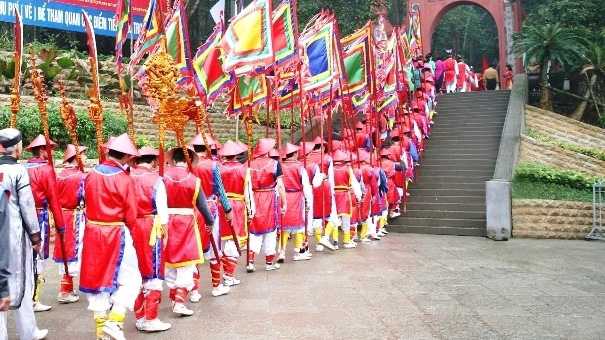
A progrmme commemorating the anniversary of Hung Kings passing, the national ancestors, and Hung Kings Temple Festival will be held from March 24 to April 2 at a national level.
The 2020 Hung Kings Temple Festival will be held from March 24 to April 2. |
The events will take place at the Hung Kings Temple historical relic site in Viet Tri City, Phu Tho Province and surrounding localities.
A range of ceremonies are scheduled for the events, including rituals commemorating the anniversary of the nation’s Great Father Lac Long Quan passing and paying tribute to the nations Great Mother Au Co; localities’ will also offer incense to Hung Kings, and a palanquin procession, among others.
There will also be various cultural, sports and tourism activities such as an art programme to open the Hung Kings Temple Festival; exhibitions; cultural camps; bronze drum beating; dragon dancing; art performances by art troupes from the provinces participating the Festival; performances of Xoan singing (a community performance art from northern Vietnam); puppetry shows at Van Lang park lake and Hung Kings Temple.
In addition, the traditional tennis tournament – Hung Kings cup, the introduction of global martial arts, and a fair for agricultural products with traditional culinary culture are expected to attract numerous visitors.
The annual events aim to honour the nation’s cultural values as well as pay tribute to the great contributions by Hung Kings and the ancestors who dedicated themselves to national construction and defence.
The programme will contribute to consolidating and promoting the national unity bloc.
Source: NDO
The People’s Committee of Lac Son district held a ceremony on April 28 to receive the provincial relic certificate for the ancient rock carving site at Suoi Co stream, located in My Thanh commune.
A special music show titled "The country is in the fullness of joy” has been held at Hoa Binh Square in Hoa Binh city in celebration of the 50th anniversary of the liberation of the South and national reunification (April 30, 1975–2025).
The People's Committee of Lo Son commune, Tan Lac district, has organised the local annual traditional stream fishing festival on April 19 - 20.
As a land deeply intertwined with human history and Vietnam’s millennia-long journey of nation-building and defence, Hoa Binh is often revered for its epic tales and legends.
Residents of Hoa Binh boast a rich cultural identity, reflected in their unique language, traditional attire, customs, and folk melodies – described as "sweet as honey, clear as a mountain stream.”
Lac Son district’s Vu ban town held the 2025 Truong Kha temple festival on April 12–13 (the 15th–16th days of the third lunar month). Since its revival in 2019, the festival has been organised every three years, preserving valuable intangible heritage while meeting the community’s cultural and spiritual needs.



